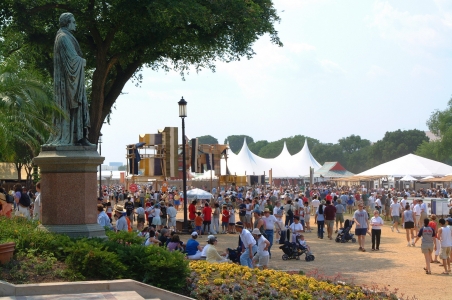The Silk Road Comes to Town This Year's Folklife Festival
For the first time in its 36 years, the Smithsonian Folklife Festival will be dedicated to a single subject: an exploration of the ancient Silk Road, the trade route that linked Asia and Europe, and its influence of its cultures on American life today.From June 26 to 30 and July 3 to 7, visitors to the National Mall can tour a range of exhibits focused on the cultures that flourished along the road from the time of Alexander the Great until the 14th century A.D. At the Capitol end of the Mall will be a pavilion built to look like the Nara Gate of Japan, and at the Washington Monument end will be a likeness of the Venice Piazza.
The annual Smithsonian festival, which last year drew 1 million visitors, generally focuses on two states as well as a particular craft -- woodworking, pottery or the like. But this year it will break tradition with the help of a very distinguished consultant, the cellist Yo-Yo Ma.
In 1998 Ma organized the Silk Road Project, a collaboration of artists who are telling the vast region's story through concerts and cultural festivals.
'What this festival can do is create an experience that is personal,' Ma said. Familiarity with the Silk Road is not necessary. 'You can come with a lot or a little, but the question is: What do you leave with?'
Ma, along with his Smithsonian partners and various curators, does not want the festival to become an instant classroom.
'It's not: Do you know the capital of Kazakhstan and can you spell Kazakhstan? I want you to know what it feels like to live someplace else. It's getting to know a world, the humanity of it all. People have always been smart and creative. Also we want to capture that sense of adventure, and what has motivated that sense of adventure,' Ma said.
The details of the Folklife Festival, called 'The Silk Road: Connecting Cultures, Creating Trust,' and the unusual approaches will be announced at a news conference today.
The event has attracted three principal sponsors, which are also underwriting Ma's project: the Aga Khan Trust for Culture, Ford Motor Co. and Siemens, the German conglomerate. At a possible cost of $6 million, the bill would be about double the usual for a Folklife Festival.
Contributing to the complexity of organizing the festival is the participation of a dozen countries, including several former Soviet republics.
'This is much more complicated than a program on New Hampshire,' said Richard Kennedy, the festival co-curator and an expert on South Asian and Southeast Asian culture. Five years ago Theodore Levine, a professor at Dartmouth who had worked with the festival, suggested the Silk Road concept. 'I thought it was logistically overwhelming and we couldn't get funding,' Kennedy said.
When Levine returned three years ago -- with Ma -- Kennedy was ready to move ahead. 'Still for us to commit the whole program was a leap,' he said. What worried him was the unfamiliarity many Americans had about the area's geography, history and culture. But since Sept. 11, Kennedy said, 'I think we have an interest in the region and a beginning of understanding.'
In addition to the evocations of Japan and Italy, the festival's main pavilions will represent 'Istanbul Crossroads,' Samarkand Square in Uzbekistan, and the Xi'an Tower of China.
The Smithsonian's approach is cultural, pulling together musicians, storytellers, cooks, potters, Sufi dervishes, embroiderers, fashion designers, stone carvers, puppetmakers, calligraphers, glass blowers and weavers from 20 countries: Armenia, Azerbaijan, Bangladesh, China, India, Italy, Iran, Japan, Kazakhstan, Kyrgyzstan, Mongolia, Nepal, Pakistan, Russia, South Korea, Syria, Tajikistan, Turkey, Turkmenistan and Uzbekistan. 'Most of our artists, 80 to 90 percent of them, have never been out of their countries before,' Kennedy said.
The festival will spotlight about 350 artists, another record for the event. Ma said consultants in the region 'have identified some fabulous people. At meetings we would actually feel sad that we couldn't bring everybody.'
Ma hopes a visitor who is a potter will watch another potter, and 'the next time the visitor picks up a newspaper and reads about information about the potter's country, they will have something to connect,' Ma said.
Kennedy said the festival would emphasize artistic links among diverse cultures. 'We will put together a Navajo weaver and a Turkish weaver, and look at how the Navajo learned to work with wool from the Spanish, and the design motifs that the Spaniards got from the Turks,' he said. Artisans from the United States, representing one-third of the participants, will show how these traditions are kept alive, and modified.
Other themes will be the development of martial arts, papermaking, truck and bus decoration in Pakistan, Syrian silk brocade weavers, the wandering minstrels known as Kushtia Bauls, and throat singing. The countries along the route introduced Chinese silk to the Mediterranean, and gunpowder, mathematics and ceramics to the West.
Music is another essential element of each Folklife Festival. With Ma sitting in from time to time, the concerts should be remarkable. Ma plans to stay the entire two weeks but he said he'd take on the character of Waldo, the children's book character who gets lost in the crowd but is always there.
'The Silk Road Ensemble will be there and I will join it at various times,' Ma said. 'My main job is trying to make sure the experience is good for anybody that comes in, and that they are leaving with what starts out as information but turns into knowledge and curiosity.'
(c) 2002 The Washington Post Company
- 5825 reads
 Ismaili.NET - Heritage F.I.E.L.D.
Ismaili.NET - Heritage F.I.E.L.D.